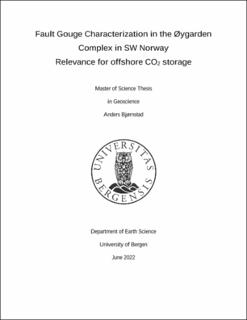| dc.description.abstract | Pre-existing structures such as faults are common within the North Sea sedimentary basin. Fault-bounded reservoirs provide significant closures for subsurface storing of CO2. An understanding of faults and fault rocks is therefore crucial for evaluating the long-term storage stability of CO2 storage sites. When injecting CO2 into a faulted or fault-bound reservoir, the increasing fluid pressure can lead to an increased risk of fault reactivation, which can cause earthquakes and alter the future fault sealing capabilities. The Smeaheia area, a newly licensed CO2 storage site (2022), at the Horda Platform in the Northern North Sea is juxtaposed with basement rocks of the Øygarden Complex to the east by the N-S striking Øygarden Fault System. The fault-related reactivation risk of the Smeaheia site towards the eastern basin-bounding Øygarden Fault System is closely linked to the characteristics of fault rocks present within the faulted crystalline basement rocks of the Øygarden Complex. Fault gouge, a clay-rich material found within the core of shallow brittle faults, is of particular interest, as this material can act as an impermeable barrier preventing fluid flow. Fault gouges represent the mechanically weakest material found within the fault core, and they may be associated with increased risk of reactivation. However, the presence of clay-rich gouge can also lower the likelihood of earthquakes by acting as a low friction gliding surface for the fault blocks, which is known as aseismic creep or stable sliding. Despite fault rocks and fault gouges being highly important for CO2 storage evaluation, the amount of data from intact offshore fault rocks is limited. In this work, we tested the friction angles of well-characterized fault rocks, i.e., fault gouges and fault breccias, from the Øygarden Complex by using accessible surface exposed onshore faults. The fault rocks were characterized by grain size distribution and mineralogy using powdered clay analysis (XRD) and thin sections (optical microscopy). To determine the friction angles, the fault rock samples were subjected to direct shear box experimentation at normal stresses ranging from 0.1 to 1.5 MPa. Six faults from the Øygarden Complex were sampled in addition to the well-documented Lærdal-Gjende fault for comparison purposes. The tested fault rocks had friction angles (ϕ) at 4 mm shear displacement (d) ranging from 17° to 31°, with a mean friction angle for the Øygarden Complex fault rocks of 23.5°. The sand-dominated gouges (45 to 67 %) had varying clay contents from 2 to 17 %. The fault gouges of the Øygarden Complex were predominantly quartzofeldspathic with clay minerals such as chlorite, kaolinite, illite and smectite. The tested fault rocks underwent systematic strain hardening during shearing at the higher normal stresses (1.0 to 1.5 MPa). However, the coarsest samples underwent significant strain hardening due to grain-locking even at the lower normal stresses (0.3 to 0.5 MPa). The results indicated no systematic correlation between the structural characteristics of the faults and the resulting friction angles. The fault rocks from the Øygarden Complex were on average weaker than the Lærdal-Gjende fault rocks and previous studies on natural gneissic fault rocks. However, significant variations were also observed between the studied fault rocks due to the heterogeneous nature of fault cores. The fault rocks showed systematic trends between the resulting friction angles, clay mineral concentrations, and grain-size properties, where clay-rich gouges had a lower friction angle. This thesis offers insight into the friction angles we can expect from fault gouges derived from the Øygarden Complex and their physical properties. This data can be used as additional input data to model the risk of reactivation and the potential for induced seismicity of the Øygarden Fault System. | |
